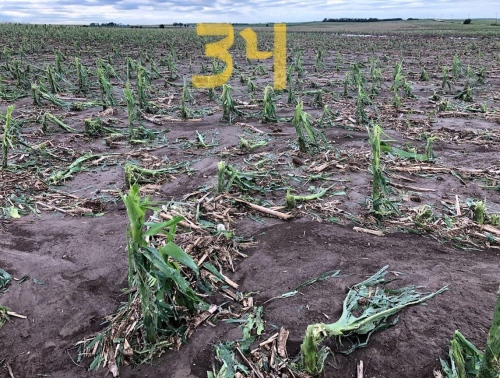
Hail damage to corn field near Hastings, Nebraska
Every year farmers face multiple weather events that can instantly undo the hard work of planting and maintaining a crop. Widespread drought and flooding can wipe out entire crops across a large area. On the other hand, hail and wind storm damage may be extremely variable. Notwithstanding the recent derecho event, a hail or wind storm might affect one farmer while not touching a neighbor’s field or damage only a specific area of the field. In particular, hail storms that occur during the growing season can be difficult to assess since actual production loss may not be fully recognized until harvest.
To assess hail storm damage, crop insurance companies rely on an adjustment procedure which would make mathematicians at MIT proud. The procedure, published by the National Crop Insurance Services, requires the adjuster count the number and leaf stage of the plants and determine the amount of defoliation and stand loss in a specific area of the field. The adjuster’s observations are plugged into a chart which calculates a percentage of loss for that area. The key is the adjuster is supposed to conduct a number of these “tests” throughout each field in order to ensure the amount of damage across each field.
Problems occur when the adjuster only conducts one test in each field. Or worse, the adjuster views the field from the road and conducts no tests; the proverbial roadside adjustment. The adjuster assumes similar damage occurred across the rest of the field and any other field the farmer claims was affected by the storm. The adjuster may rationalize his adjustment does not matter because the farmer may be paid based on the actual yield loss determined at harvest.
Hail crop insurance policies may pay for actual production loss determined at harvest. However, the catch is the policy likely allows the insurer to pay the lesser of the adjuster’s initial assessment and the actual production loss. Simply put, if the roadside adjustment assesses the hail damage at 15% while harvest proves an actual production loss of 35%, the insurer will pay the 15% loss assessment. Consequently, the farmer may end up missing out on full reimbursement due to a roadside adjustment.
Therefore the following steps could help ensure a competent adjustment:
- Report the claim as soon as possible to your agent;
- Actively participate in the adjustment to ensure the adjuster conducts multiple tests in each field which suffered damage;
- Request copies of the adjuster’s damage assessment or otherwise record the adjusters assessment;
- Maintain accurate records of subsequent weather events and harvest yields; and
- Contact an attorney if the actual production loss is significantly higher than the adjuster’s initial assessment. The policy likely limits the time to dispute the insurance company’s adjustment.


Leave A Comment